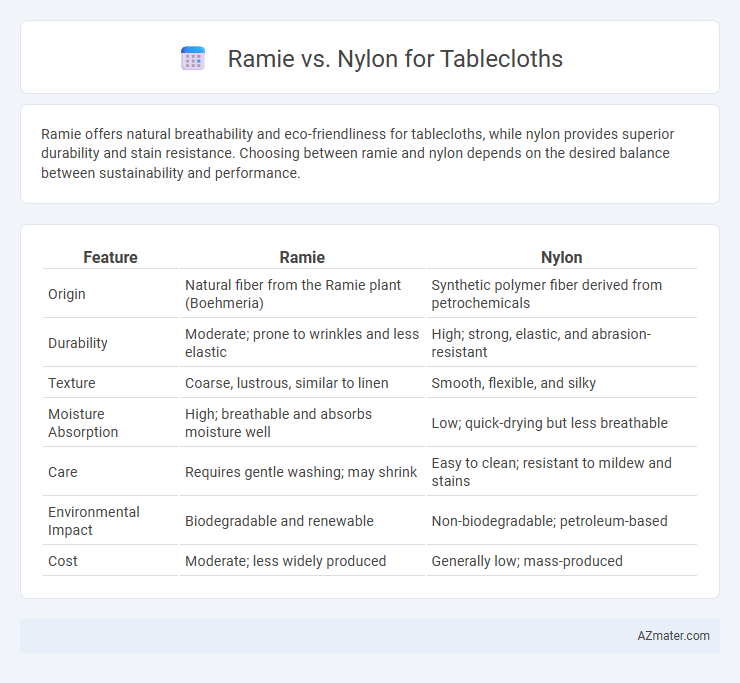Ramie offers natural breathability and eco-friendliness for tablecloths, while nylon provides superior durability and stain resistance. Choosing between ramie and nylon depends on the desired balance between sustainability and performance.
Table of Comparison
| Feature | Ramie | Nylon |
|---|---|---|
| Origin | Natural fiber from the Ramie plant (Boehmeria) | Synthetic polymer fiber derived from petrochemicals |
| Durability | Moderate; prone to wrinkles and less elastic | High; strong, elastic, and abrasion-resistant |
| Texture | Coarse, lustrous, similar to linen | Smooth, flexible, and silky |
| Moisture Absorption | High; breathable and absorbs moisture well | Low; quick-drying but less breathable |
| Care | Requires gentle washing; may shrink | Easy to clean; resistant to mildew and stains |
| Environmental Impact | Biodegradable and renewable | Non-biodegradable; petroleum-based |
| Cost | Moderate; less widely produced | Generally low; mass-produced |
Introduction: Ramie vs Nylon Tablecloths
Ramie tablecloths boast natural fibers derived from the nettle plant, offering exceptional breathability, durability, and an eco-friendly alternative to synthetic materials. Nylon tablecloths, made from synthetic polymers, provide superior stain resistance, wrinkle-free properties, and enhanced longevity in high-traffic or outdoor settings. Comparing Ramie and Nylon tablecloths reveals distinct advantages in sustainability, texture, and maintenance that influence fabric choice based on usage and aesthetics.
Material Overview: What is Ramie?
Ramie is a natural fiber derived from the stalks of the Chinese flowering plant, known for its durability and lustrous appearance, making it an eco-friendly choice for tablecloths. Its strong, absorbent, and breathable properties provide resistance to wrinkles and mildew, distinguishing it from synthetic fibers like nylon. Unlike nylon, which is a petroleum-based synthetic fiber valued for its elasticity and stain resistance, ramie offers a biodegradable alternative with a unique textured finish ideal for elegant and sustainable table settings.
Material Overview: What is Nylon?
Nylon is a synthetic polymer known for its exceptional strength, elasticity, and resistance to abrasion, making it a durable choice for tablecloths. This material is lightweight, quick-drying, and offers excellent resistance to mildew, stains, and wrinkles, enhancing its suitability for frequent use and easy maintenance. Compared to natural fibers like ramie, nylon provides superior durability and stain resistance but may lack the breathable and eco-friendly qualities preferred in sustainable textiles.
Durability Comparison: Ramie vs Nylon
Ramie tablecloths offer strong natural fiber resilience but tend to be less resistant to abrasion and moisture compared to nylon. Nylon tablecloths provide superior durability, exhibiting high resistance to wear, stretching, and water damage, making them ideal for heavy-use environments. Overall, nylon outperforms ramie in longevity and maintenance ease, especially in settings prone to spills and frequent laundering.
Stain Resistance: Which Material Performs Better?
Ramie offers natural stain resistance due to its coarse fibers that repel moisture and inhibit stain absorption, making it effective for light spills on tablecloths. Nylon, a synthetic fiber, exhibits superior stain resistance through its non-porous surface that prevents liquids from penetrating, allowing for easier stain removal and enhanced durability. Overall, nylon outperforms ramie in resisting stains, especially in environments prone to frequent spills and heavy use.
Appearance and Aesthetics
Ramie tablecloths feature a natural, linen-like texture with a soft sheen that enhances rustic and elegant decor, while nylon options offer a smooth, glossy finish that reflects light for a sleek, modern look. The matte finish of ramie provides a more organic, handcrafted appearance, ideal for traditional or farmhouse styles. Nylon's vibrant color retention maintains a crisp, polished aesthetic, perfect for contemporary settings seeking durability without sacrificing visual appeal.
Maintenance and Cleaning Ease
Ramie tablecloths require gentle hand washing or dry cleaning to maintain their natural fibers, as they are prone to shrinking and damage from harsh detergents. Nylon tablecloths offer superior ease of maintenance with machine washability, quick drying, and resistance to stains and wrinkles. Choosing nylon ensures long-lasting durability with minimal cleaning effort, while ramie demands more delicate care to preserve its texture and appearance.
Eco-Friendliness and Sustainability
Ramie tablecloths offer superior eco-friendliness due to their biodegradable nature and minimal pesticide use during cultivation, making them a sustainable choice for environmentally conscious consumers. Nylon, derived from petroleum, is non-biodegradable and has a significant carbon footprint, contributing to environmental pollution throughout its lifecycle. Choosing ramie over nylon aligns with sustainable practices by reducing plastic waste and supporting renewable plant-based fibers in table linen production.
Cost and Value for Money
Ramie tablecloths offer a natural, eco-friendly option with moderate cost, generally priced lower than high-quality nylon alternatives. Nylon tablecloths provide exceptional durability and stain resistance, often justifying their higher price through longevity and easy maintenance. When evaluating cost and value for money, ramie suits budget-conscious buyers seeking sustainable fabric, while nylon appeals to those prioritizing long-term use and resilience.
Best Applications for Ramie vs Nylon Tablecloths
Ramie tablecloths excel in applications requiring natural fiber qualities such as breathability, eco-friendliness, and a soft luster, making them ideal for formal dining settings and outdoor gatherings with a rustic or vintage theme. Nylon tablecloths are best suited for heavy-duty use, offering superior durability, stain resistance, and easy maintenance, which makes them perfect for commercial settings like restaurants and events with high foot traffic. Choosing ramie enhances natural aesthetic appeal, whereas nylon prioritizes practicality and longevity.

Infographic: Ramie vs Nylon for Tablecloth
 azmater.com
azmater.com